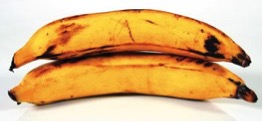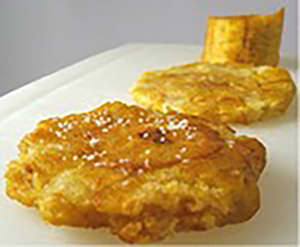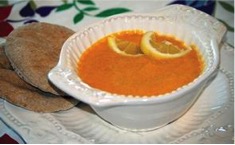Yes, We Have No Bananas
A staple of Latin American cuisine, the versatile plantain can be served as a savory side dish or a sweet dessert.
When passing the bunches of ripe and green plantains at the supermarket, I can easily imagine a cynical voice murmuring, “Move along, gringa. You’ll never cook platanos like a South American.”
The Valley’s early Dutch settlers were less intimidated. Nearly 300 years ago, they used starchy-sweet plantains from Latin America as a substitute for potatoes, flour, and even sugar; New Amsterdam Dutch references mention dried plantains being ground into a sweet flour and shipped north from Suriname (formerly Dutch Guyana). Today, many of us are refamiliarizing ourselves with this fruit which, although plentiful, often falls outside our culinary domain.
Plantains look like big bananas, and both fruits are sweet when ripe, but that’s about where the similarity ends. We usually set aside green bananas to ripen before eating or cooking. But both green and ripe plantains are widely used in Latin American cooking, and extremely ripe plantains are occasionally eaten raw. In general, green plantains are treated more like a vegetable, while the completely ripe, black plantains are used in both dinner and dessert recipes. The two versions of the fruit are so popular in Caribbean restaurants that diners merely specify “platanos verde” or “platanos maduros” when requesting a side order.
Plantains most frequently appear split and fried. Because they are starchy like potatoes, they fry up more crisply than one might expect. Like bananas, they convert starch to sugar as they ripen (although plantains start with more starch in the first place). Tostones — the plantain chips that many Americans are familiar with — traditionally have been made with green plantains. But these days sweeter versions are showing up on the menus of more adventurous chefs. The crowning green plantain dish of the Spanish-speaking Caribbean is mofongo. In the classic version, plantains are boiled, fried, mashed in a mortar with garlic and other spices, then mixed with pork and vegetables. For stews, green plantains can be simmered in a Dutch oven with chicken, beef, or seafood.
Tostones: Think Fried Banana chips
Photograph courtesy of saraverstynen.com
One gets an idea of how versatile plantains can be from the fusion “world Latin cuisine” at Sabroso in Rhinebeck. “We use them instead of mashed potatoes or mashed sweet potatoes, with a variety of seasonings,” says co-chef and co-owner Marcia Miller.
On other occasions, pastelles — crisp, thin dough wrapped around a sweet plantain filling — accompany a spicy tuna dish. In a marinated pote (a Spanish stew), ripe plantains substitute for refined sugar. Green plantains also show up in a more stylized Iberian stew. The fried-pounded-and-fried-again tostones are served in place of toasted bread. “If diners want to scoop up their salsa, they can use them like crostini,” says Miller.
In her cooking classes at Sabroso, Miller ensures that good plantain recipes get passed along — and created. “People think it’s foreign and it really isn’t,” she explains. “I'll say, ‘Think of ripe bananas. What would you use them for? Think of a starchy potato you want to fry.’ I encourage blending, substitution of imagination and memory. I try to help students access a memory of something familiar to them, like French fries, and try to link the preparation of plantains and these more familiar foods in their minds.”
Having lived for a time in Haiti and traveled throughout the Caribbean, Miller herself has no difficulty recalling one of her own favorite meals. “I have fond memories — I can smell the sweet plantains and eggs in the morning.”
PASTELLES
Chefs Marcia Miller and Erica Mahlkuch, Sabroso, Rhinebeck
Yield: 12-15 pastelles, depending on thickness
3-4 ripe plantains, peeled and diced
3 Tbs butter
¼ cup tightly packed brown sugar
1 tsp nutmeg
1 tsp salt
3 Tbs Meyers rum
1 package spring roll wrappers
½ cup canola oil
Egg wash: 2 eggs mixed with 1 Tbs milk
For coating: 1 cup sugar with 2 tsp cinnamon
Blend first six ingredients in a food processor until smooth. Spread a tablespoon of filling in a line down the center of each wrapper, starting about a third of the distance from the top. Fold ends in slightly, and then roll like a cigar. Using a pastry brush or your finger, brush ends with egg wash to make certain the shape stays closed.
Heat one inch of canola oil in a fryer or deep sauté pan over high heat. Fry pastelles for 3 to 5 minutes, until golden brown. Drain and roll in sugar mixture
Serve as a dessert or with a spicy savory dish.
Muy delicioso!
Recipe from Sabroso



